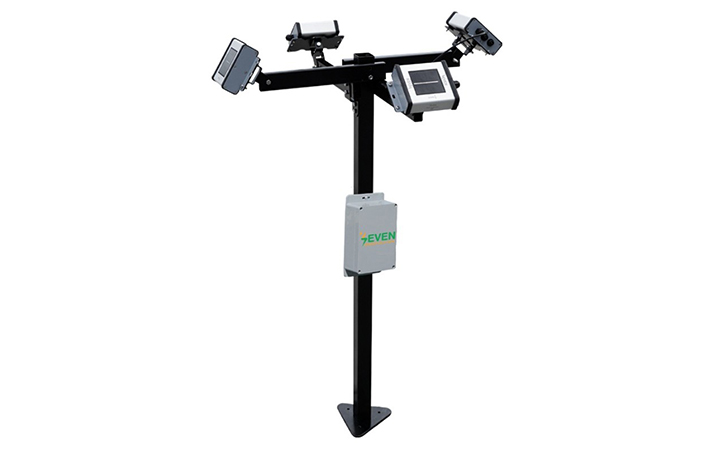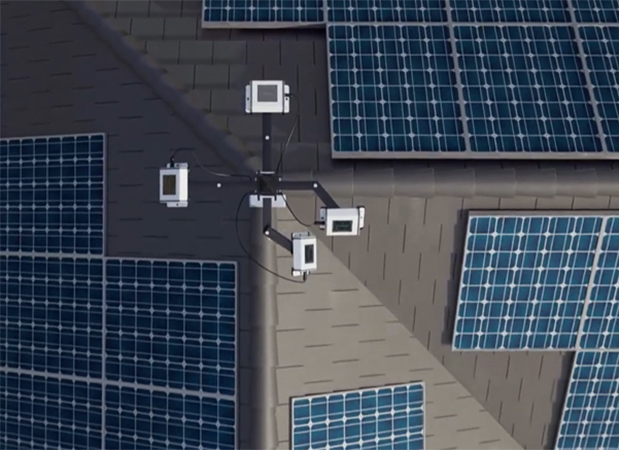As PV system designs become more diverse, with multi-directional rooftop Configuration, the need for accurate, multi-plane irradiance data has never been greater. The SEVEN Multi-Orientation Irradiance Sensor delivers comprehensive irradiance measurements across three or more module orientations, enabling accurate performance modeling and reliable energy assessment for even the most complex solar plants.
What Is a Multi-Orientation Irradiance Sensor?
The SEVEN Multi-Orientation Irradiance Sensor is a set of three or four independently calibrated reference cells connected to a connection box allowing the communication via Modbus RTU. Each of the sensors is mounted at specific tilt and azimuth angles that match the real-world orientations of the PV modules. It is designed for systems with more than two PV orientations, such as east-west-flat rooftops, dual-tilt tracker systems…
Using a SEVEN Configuration Tool, the number of modules per orientation is entered so that the system calculates total effective irradiance for accurate performance ratio (PR) analysis of mixed-layout systems.

Where:
- Actual Energy Output = Actual reading of the plant
- Expected Energy Output = Theoretical, calculated nominal energy output based on the total effective irradiance, defined as:

- ISi: Irradiance from Orientation i
Key Features of Multi-Orientation Irradiance Sensor
- 3 or 4 Independent Reference Cell Sensors
Each sensor is mounted at a pre-defined tilt and azimuth to match the PV system layout. - Class A Accuracy (<1.2%)
Sensors comply with IEC 61724-1:2021 Class A standards for reliable field performance monitoring. - Total Effective Irradiance Output
Automatically calculated by SEVEN’s configuration tool using the module ratio of each orientation. - Digital Output via Modbus RTU (RS485)
Easy integration into SCADA, inverters, and data acquisition systems. - Rugged Design for Harsh Environments
IP54-rated weatherproof housing; optional IP68 for demanding conditions. - Optional Mounting System
SEVEN offers a Mounting System with adjustable brackets for Irradiance Sensor to ensure their correct installation.

How Does Multi-Orientation Irradiance Sensor Work?
- Each sensor is mounted to replicate the tilt and azimuth of the corresponding PV string or module group.
- The system outputs individual irradiance values for each orientation.
- Using the sensor configuration tool, you define the PV module ratio per orientation by entering the number of panels in each orientation.
- The unit then calculates and outputs a total effective irradiance value, weighted according to system design, for use in PR calculations.
Why Use a Multi-Orientation Sensor?
Many modern PV plants feature mixed orientations due to land constraints or rooftop design. With the SEVEN Multi-Orientation Sensor, operators can:
- Avoid duplicating dataloggers or inverters for each orientation
- Ensure accurate, unified performance ratio analysis across all orientations
- Monitor and compare real-time irradiance conditions across different sections of the plant
- Reduce complexity and cost compared to deploying multiple independent sensors
Integration & Compatibility of Multi-Orientation Irradiance Sensors
SEVEN Multi-Orientation Irradiance Sensors are fully compatible with:
- SCADA and energy management systems
- Inverter-based monitoring systems
- Custom dataloggers
Best Practices for Installing Multi-Orientation Irradiance Sensors
To achieve optimal results:
- Ensure each sensor is mounted at the correct tilt and azimuth, matching its respective module group. You can use SEVEN Mounting Structure for this.
- Use SEVEN’s Configuration Tool to input the accurate module distribution per orientation
- Keep sensor surfaces clean and inspect regularly for soiling
- Install in a location with unobstructed exposure to sunlight, avoiding shadows from nearby modules or structures
SEVEN Multi-Orientation Irradiance Sensor: Built for Real-World Complexity
Whether you’re deploying a multi-row bifacial layout, a high-density rooftop project, or a custom tracker array, the SEVEN Multi-Orientation Irradiance Sensor gives you the complete visibility you need to monitor, model, and maximize PV performance, all in one integrated unit.
Need help configuring your sensor?
Contact SEVEN’s Technical Team for expert guidance and commissioning support.
